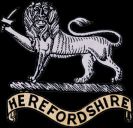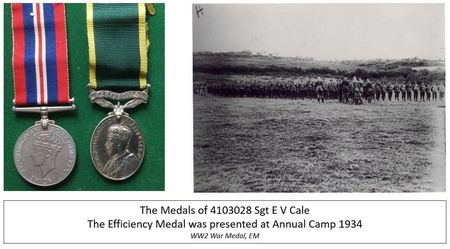
Volunteer Medals
Introduction
The Volunteer Forces had their own class of service medals; there was a time served requirement and a need to demonstrate ‘efficiency’ this normally involved attending certain training and annual camp. As a result of this second requirement the service medal became known as the Efficiency Medal.
Different medals were awarded to soldiers and officers, the officers medal was classed as a decoration which entitled them to near the appropriate post-nominal title.
The following sections cover only those Territorial Medals and Decorations which the Herefordshire Rifle Volunteer Corps, The Herefordshire Regiment and the Herefordshire Light Infantry were eligible for.
1892 - 1908
The Volunteer Force
The Volunteer Force Long Service Medal (VFLSM) was medal was awarded for 20 years service, it was initiated in 1892 and the qualification period ended on the formation of the Territorial Force in 1908.
Officers received the Volunteer Decoration and were entitled to the post nominals ‘VD’. The VD included the Victorian or Edwardian Royal Cypher.
The VFLSM bears the head of Queen Victoria and King Edward VII as appropriate.


1908 -1921
The Territorial Force
The Territorial Force was formed in 1908 and new medals were introduced.
The Territorial Force Efficiency Medal (TFEM) was introduced for soldiers and the Territorial Decoration for Officers. The qualification period was 12 years service which had to include attendance at 12 annual camps. Previous service in the Volunteer Force counted and war service counted double. Bars were worn on the ribbon of the medal for additional 12 year periods of service. The Ribbon was changed in 1919.
Recipients of the Territorial Decoration could use the post-nominals ‘TD’.
The TD bore the Royal Cypher, and the TFEM the head of Edward VII or George V, as appropriate.
1921 - 1930
The Territorial Army
The Territorial Force was retitled the Territorial Army in 1921 and new medals introduced.
The Territorial Efficiency Medal (TEM) was introduced for soldiers and the Territorial Decoration for Officers. The qualification period was 12 years service which had to include attendance at 12 annual camps. Previous service in the Volunteer Forces counted and war service counted double. Bars were worn on the ribbon of the medal for additional 12 year periods of service.
Recipients of the Territorial Decoration could use the post-nominals ‘TD’.
The TD bore the Royal Cypher, and the TEM the head of George V.

1930 - 1999
The Territorial Army
The Efficiency Medal, sometimes referred to as the Efficiency Medal (Territorial) (EM(T)) was instituted in 1930; it was awarded for 12 years service and bars were awarded for further periods of 6 years service. Alongside the Efficiency Medal the Territorial Decoration continued to be awarded.
The medal could bear the bar ‘TERRITORIAL’, MILITIA’ ‘ARMY EMERGENCY RESERVE’ or TA&VR’. The Militia version was never issued to the Herefordshire Regiment.
The medal and TD were issued in the reigns of George V, George VI and Elizabeth II and bear the appropriate Royal Cypher and head.
The Medal covers the period 1930 to 1999 and medals are named to: The Herefordshire Regiment, The Herefordshire Light Infantry, The Shropshire and Herefordshire Light Infantry and the Light Infantry (Volunteers).
1999 -
The Army Reserve
The Volunteer Reserve Service Medal (VRSM) was introduced in 1999, it replaced the Efficiency Medal and the Territorial Decoration - all ranks were awarded the VFSM.
The medal is awarded for 10 years service.
Recipients may use the postnominals ‘VR’
In 2013 the Territorial Army was retitled the Army Reserve and Drills Halls retitled Army Reserve Centres.









